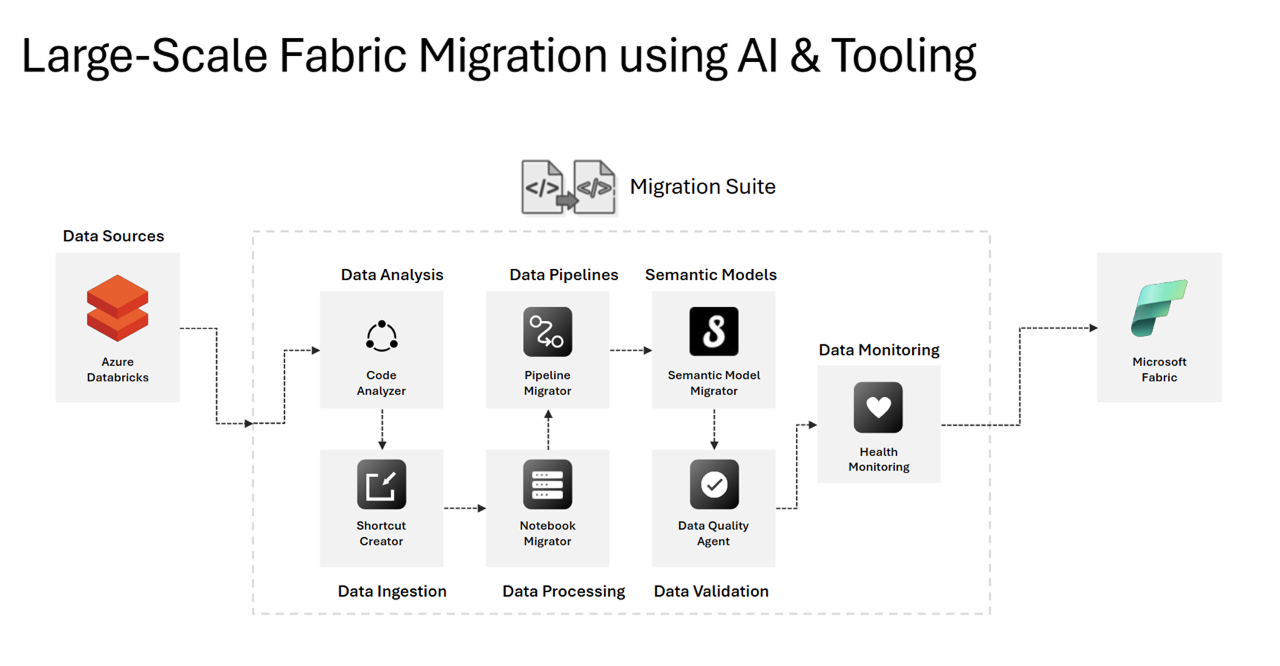Introduction
For enterprise organizations, achieving one source of truth (OSOT) is key to ensuring data consistency, accuracy, and efficiency. Our client—a multinational technology corporation—sought to establish OSOT while enabling AI-powered capabilities in their reporting and analytics workflows. Microsoft Fabric, with its unified platform and built-in AI features, was the ideal solution to help achieve their objectives.
Business challenges
The client, a global technology enterprise, had been relying on Azure Databricks for analytics and reporting for over a decade. However, data duplication and performance issues from the original lift-and-shift migration to Databricks led to increased costs and inefficiencies. Furthermore, following the launch of Microsoft Fabric, the client wanted to adopt the platform early to unlock AI capabilities. The migration presented a key opportunity for a major data clean-up and to establish OSOT while maintaining legacy functionality.
Migration stages
The migration comprised six key stages:
1. Assess & evaluate: Define goals, assess current architecture, and determine technical fit.
2. Plan & design: Design target architecture using the Well-Architected Framework, assess migration readiness, estimate resources, and build a migration plan.
3. Pilot: Migrate an identified workload to Fabric, identify automation opportunities, and review final outcomes.
4. Migrate & optimize: Migrate data products, pipelines, and semantic models using accelerators, optimize cost, performance, security, and scalability.
5. Monitor & govern: Track cost, security, and performance, assess governance, and set up operational dashboards and alerts.
6. Establish Fabric COE: Standardize practices, define best practices, and lead strategic initiatives for long-term success.
Our innovative approach
To support a smooth and efficient migration, we introduced a range of innovations that improved speed, consistency, and quality across the project. These included custom-built automation tools, the use of Microsoft Copilot for accelerated code generation, and selective integration of open-source libraries. Together, these innovations helped reduce manual effort, allowing our team to deliver faster while ensuring high data quality and preserving legacy functionality.
Additionally, given the scale and complexity of the data landscape, a key challenge was consolidating reports and models without losing critical legacy capabilities built on Azure Databricks. We ensured seamless integration with Power BI by selecting DirectLake via the SQL endpoint. This delivered superior performance (due to caching) and introduced fewer security concerns than alternatives.
We also implemented a data mesh architecture to promote domain-oriented ownership, improve scalability, and enhance data governance across teams.
Key automation and AI-enhanced capabilities included:
· Code analysis: Automated end-to-end lineage and metric traceability to perform faster impact analysis.
·
Shortcut creation: Created a tool to automatically create and manage shortcuts for upstream sources.
·
Notebook and pipeline migration: Streamlined conversion of Databricks notebooks and pipelines to Fabric using a customizable, rule-based AI engine and dependency object creator.
·
Semantic model migration: Automated migration using BIM files, enabling seamless transfer of measures, relationships, and hierarchies. The process also includes intelligent correction of mismatched relationships to ensure model integrity.
·
Data quality validation: Created an event-driven framework to perform advanced validation checks, provide smart recommendations, and enforce Fabric best practices with custom AI agents.
·
Migrate and optimize: Accelerated workload migration using purpose-built tools, while optimizing for cost, performance, security, and scalability.
Lastly, ADO Copilot (MerlinBot) was used to review Pull Requests and provide recommendations based on feedback, further streamlining development and reducing manual overhead. These innovations collectively enabled an accelerated, low-risk migration that preserved legacy capabilities and delivered AI-powered analytics.
| Figure 1: Solution architecture |
Outcomes
· OSOT: Users can now access a trusted, unified view of data directly from the SQL endpoint.
·
Report and model consolidation: Reduced the number of reports by 48% (from ~110 to ~50) and models by 50%, significantly reducing the data footprint.
·
Faster time to insight: Monthly financial data is now available 40% earlier, improving decision-making during the fiscal close period.
·
Clear ownership: The new data mesh architecture clarified domain ownership, enhancing accountability and governance.
·
Reduced costs: Projected reduction in sustained platform costs by 15–25% due to consolidation and architectural improvements.
Interested in learning more?
As a Microsoft Fabric Featured Partner, MAQ Software brings deep expertise in helping organizations unlock the full potential of Microsoft Fabric. Whether you're looking for guidance on implementing data solutions or optimizing your existing platform, we’re here to support you every step of the way.
Contact us at CustomerSuccess@MAQSoftware.com or explore our apps or consulting services on Microsoft Azure Marketplace:


